NREL Water Power Research Flourishes Under Seedlings Program
Small Projects Benefit From Unique Funding Opportunity
Working in a chocolate factory may sound sweet, but during Ravi Kishore’s tenure working on one of Nestle’s factory floors, he was more focused on identifying inefficiencies and reducing waste than he was on sampling the product. During that time, amidst whirring machines, piles of confections, and puffs of steam, Kishore landed on an idea: What if we could actually harvest all the thermal energy that is wasted in the chocolate production process?
Years later, he investigated that idea in his doctoral dissertation on low-grade thermal conversion and energy harvesting. And now, as a water power research engineer at the National Renewable Energy Laboratory (NREL), Kishore is turning his ideas about thermal conversion into an ocean-based technology that converts heat into electricity using just the difference in temperature between the surface of the ocean and the ambient air. His simple device could autonomously help monitor weather, track wildlife, measure ocean acidity levels, and more.
The idea that was sparked for Kishore all those years ago has evolved into a working prototype, thanks to funding from the Seedling and Sapling program created by the U.S. Department of Energy’s Water Power Technologies Office (WPTO). The program provides funding to national laboratory researchers, empowering them to think outside the box when it comes to their water power research—and to fine-tune their ideas so they have real-world applications.
“The Seedling funding helped me narrow down the design of these thermomagnetic generators and identify the most deployable design,” Kishore said.
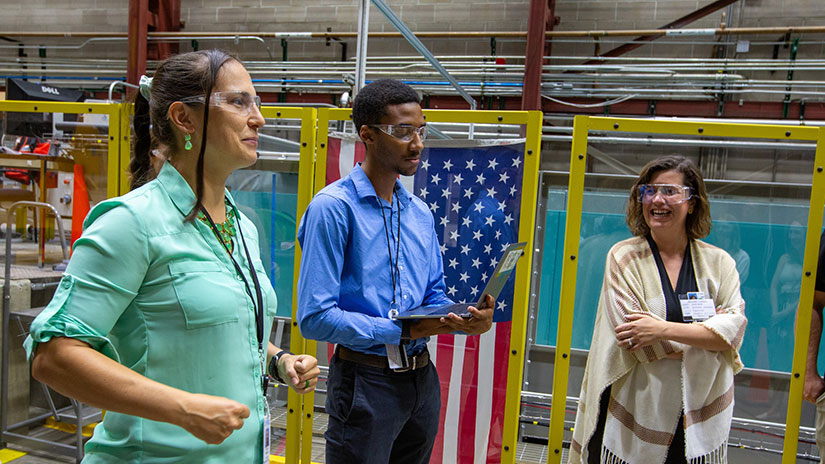
WPTO Director Jennifer Garson (right, with NREL senior researcher Nicole Mendoza and intern Kameron Robinson) visited NREL’s Flatirons Campus in August 2023 to learn more from researchers about ongoing WPTO-funded projects. Photo by Taylor Mankle, NREL
A Recipe for Growth
Through the program, researchers propose a small hydropower or marine energy project—one that can be accomplished within a year and under $100,000—that they feel uniquely qualified to tackle. A team of experts at WPTO then gives the go-ahead to projects that they think will move the needle on water power research and help the country achieve its decarbonization goals.
NREL’s marine energy researchers have taken full advantage of the funding, winning 27 awards since the program began in Fiscal Year 2020.
“The Seedling program is a great way for newer researchers to get access to smaller buckets of funding,” said Eric Parker, an NREL project controller who provides program-level support for marine-energy-focused Seedlings. “It allows them to get experience in leading research—experience that will grow as they progress their Seedlings concept.”
After their first Seedling award, researchers can apply for another round of funding for a Continuing Seedling project; promising projects can later apply to become a Sapling and receive funding of $150,000 to $500,000.
The benefits of the Seedling and Sapling program do not just apply to researchers, however. The program also serves as a way for WPTO to identify new areas of research that could be absorbed into its regular funding streams to national laboratories. “It’s a lower-risk way of establishing new pillars of R&D within WPTO’s Marine Hydrokinetic Program at NREL,” Parker said.
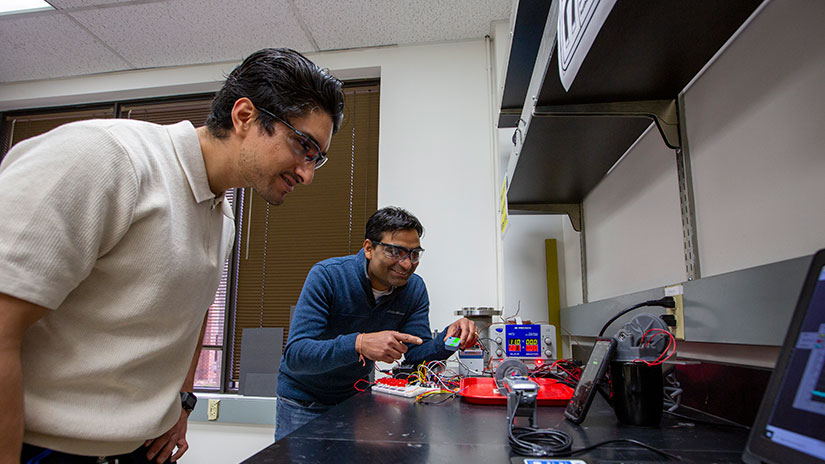
NREL researchers Ravi Kishore and Erick Moreno Resendiz pose next to their thermomagnetic generator (TMG), which converts thermal energy into mechanical or electrical energy utilizing the thermomagnetic effect. Photo by Taylor Mankle, NREL
Seedlings and Saplings in Progress
Multiple recent Seedling projects have been given the green light—and more funding—to build on their research as either Continuing Seedlings or Saplings. Much like Kishore’s project, many of them are centered around developing offshore energy to serve ocean observing, desalination, and other applications involved in the Powering the Blue Economy™ (PBE) initiative.
Sapling: Thermomagnetic Generators: A Novel Heat Engine for Powering the Blue Economy
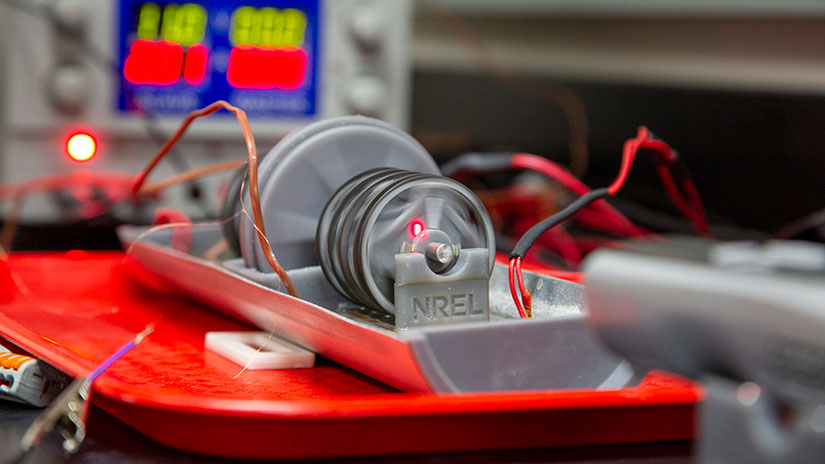
Ravi Kishore and his team built a miniature prototype of a thermomagnetic generator that converts thermal energy present on the ocean’s surface into electricity. Photo by Taylor Mankle, NREL
After his initial round of Seedling funding, Kishore had a feasible design for a regenerative thermomagnetic generator that generates electricity using just the temperature differential between the ocean and the air. His team even built a miniature working model that successfully produced energy when placed over a cup of coffee.
Now, with $500,000 of Sapling funding, Kishore’s team will work on developing a full prototype—imagine a small boat, outfitted with a thermomagnetic generator, floating autonomously at sea—that will serve as the next step toward commercialization.
Sapling: Loads Data for Reference Model Composite Tidal Turbine Blades Using Instrumentation Best Practices and Submerged Blade Validation
Tidal turbines have huge potential to provide clean energy to coastal communities. But the industry could greatly benefit from more information on how to cost-effectively fabricate turbine blades, equipped with the right instrumentation, that are resilient enough to withstand turbulent and corrosive undersea conditions.
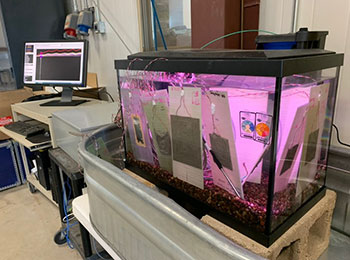
Tidal turbine strain gauges, made using a variety of different techniques, coatings, and adhesives, were tested in a saltwater tank for up to one year during this Seedling project. Photo by Andrew Simms, NREL
Now a Sapling that was recently awarded $250,000, the team will take their Seedling findings and begin developing methods and practices for integrating strain gauges and other sensors with full-size tidal turbine blades. They will then validate their ideas by manufacturing the instrumented blades and submerging them in ocean-like conditions in the lab to see how well they hold up. The resulting information will help refine the development of long-lasting tidal turbines.
Phase 2 Seedling: Investigating the Effects of Short Waves (Chop) on Wave Energy Converters
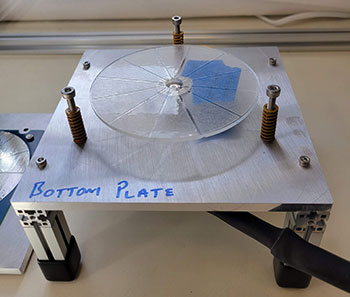
NREL researchers are using Seedling funding to perform benchtop testing of triboelectric nanogenerators, or TENGS, for use in large-scale wave energy converters. Pictured is the team's rotary TENG prototype on a custom test rig that was built to characterize the power production of a single-layer rotary TENG. Photo by Calum Kenny, NREL
In this Seedling, which just received a second $50,000 award, NREL researchers are adding more capabilities to the award-winning WEC-Sim simulation software; their additions will model the effect that short waves can have on the performance of WECs. The team will then use the enhanced software to investigate the effect of wave chop on multiple reference models of marine energy devices. The team hopes to publish their findings to provide researchers with information on how wind chop might impact small devices and directional WECs.
Phase 2 Seedling: Novel Materials Approach to a 10-Watt WEC for PBE Applications Using Triboelectric Nanogenerators
Triboelectric nanogenerators, or TENGs, are a nascent class of energy harvesters that use an effect similar to static electricity to produce power. Thus far, they have mostly been studied in small wave energy applications that use the agitation of the ocean surface to power low-power sensors.
Larger PBE applications, such as ocean observation, require more substantial wave-energy-derived power. This Continuing Seedling was awarded an additional $50,000 to enable NREL researcher Calum Kenny and his team to create a 10-watt TENG WEC that employs a frequency multiplier device to maximize the energy harvested from a TENG. The team is performing benchtop testing to identify ways to increase power output and conducting a techno-economic study to explore the feasibility of the device.
The Past and Future of the Program
While these projects will continue in the next year, many past Seedling projects have covered the spectrum of potential marine energy topics, including:
- WECs designed to use the natural accumulation of barnacles and algae to increase their energy-capturing potential
- Self-charging underwater autonomous vehicles for kelp forest restoration
- Marine-energy-supported carbon dioxide removal
- Undersea energy storage
- Colocating marine energy with aquaculture operations (e.g., fish farming)
- Electrolytic limestone generation for coastal resilience applications.
Ultimately, the research ideas initiated by these Seedlings and Saplings can help guide WPTO’s selection of projects destined for larger funding.
While the idea that was sparked for Kishore on the chocolate factory floor is closer to becoming a reality, there is still significant R&D to perform, he says. But thanks to the Seedling and Sapling program, Kishore will be much better prepared to apply for the larger bucket of funding he needs to meet his goal of commercialization.
Learn more about NREL’s water power research, and subscribe to the NREL water power newsletter, The Current, to make sure you don’t miss a water power update.
Last Updated May 28, 2025
